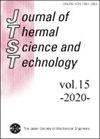Experimental investigation of a thermally driven pumping system for a potential application with a microgrid system for rural communities
IF 1.2
4区 工程技术
Q3 THERMODYNAMICS
引用次数: 0
Abstract
Renewable energy-based microgrid systems are widely being studied as electrification methods for rural communities in developing countries. Waste heat generated by the components of the microgrid systems, such as the biogas driven generators (BDG), presents the potential of utilizing the low-grade heat in a way that can contribute to the sustainability of such energy systems. From the points of view of affordability, local manufacturability, and applicability for agriculture, thermally driven pumps (TDP) may be attractive for coupling with such microgrid systems. Therefore, the current study has focused on the development of a new type of thermally driven pumping system as a potential waste heat utilization component for microgrid applications in rural areas. A liquid piston-type TDP concept without moving parts, except few valves, was developed and parametric experimental investigations were carried out. The performance and characteristics of the system were studied, which revealed that the proposed system has a superior performance compared to the literature. It was also found that the system performance strongly depends on the heat addition rate and delivery capacity of the system, which are suitable characteristics for the intended application. Hence, the experimental data were used to estimate whether the proposed system can pump enough water that needs to be supplied for the biogas production to supply a 10 kW BDG unit of a microgrid. It was found that 87 – 93% of the total pumped water (13 – 27 m 3 ) would be available for agricultural and other purposes while only 6 – 13% would need to be fed to the biogas digester. Generally, the results seem to be promising, and yet there are potentials for the optimization and improvement of the proposed system, hence they have been pointed out.热驱动抽水系统在农村微电网系统中的潜在应用实验研究
基于可再生能源的微电网系统正被广泛研究作为发展中国家农村社区的电气化方法。微电网系统的组成部分产生的废热,如沼气驱动发电机(BDG),提供了利用低品位热量的潜力,可以促进这种能源系统的可持续性。从可负担性、本地可制造性和农业适用性的角度来看,热驱动泵(TDP)可能具有与此类微电网系统耦合的吸引力。因此,目前的研究重点是开发一种新型的热驱动泵系统,作为农村微电网应用的潜在余热利用组件。提出了一种除少量阀门外无运动部件的液体活塞式TDP概念,并进行了参数化实验研究。对系统的性能和特性进行了研究,结果表明,与文献相比,所提出的系统具有优越的性能。研究还发现,系统性能在很大程度上取决于系统的热添加率和输送能力,这是适合预期应用的特性。因此,实验数据被用来估计所提出的系统是否可以抽出足够的水来供应沼气生产所需的水,以供应一个10千瓦的微电网BDG单元。结果发现,总抽水量的87 - 93%(13 - 27立方米)可用于农业和其他目的,而只有6 - 13%需要用于沼气池。总的来说,结果似乎是有希望的,但仍有潜力的优化和改进所提出的系统,因此指出了它们。
本文章由计算机程序翻译,如有差异,请以英文原文为准。
求助全文
约1分钟内获得全文
求助全文
来源期刊
CiteScore
2.30
自引率
8.30%
发文量
0
审稿时长
5 months
期刊介绍:
JTST covers a variety of fields in thermal engineering including heat and mass transfer, thermodynamics, combustion, bio-heat transfer, micro- and macro-scale transport phenomena and practical thermal problems in industrial applications.

 求助内容:
求助内容: 应助结果提醒方式:
应助结果提醒方式:


